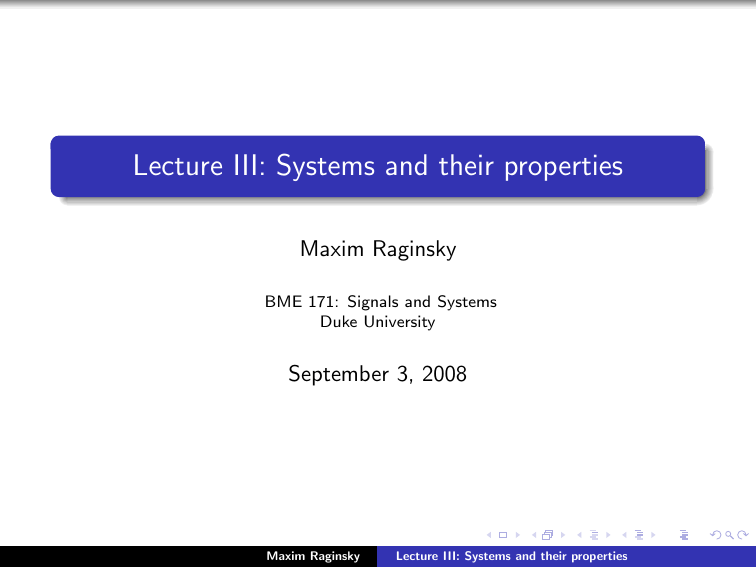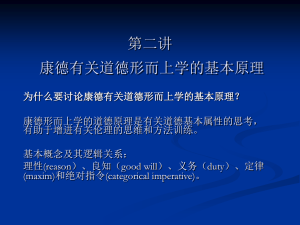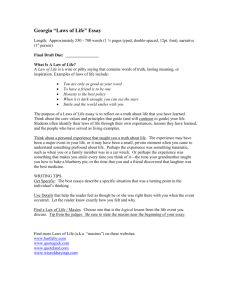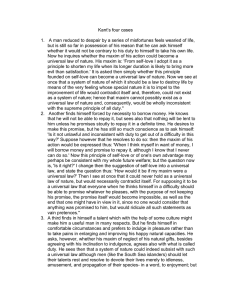Lecture III: Systems and their properties
advertisement

Lecture III: Systems and their properties Maxim Raginsky BME 171: Signals and Systems Duke University September 3, 2008 Maxim Raginsky Lecture III: Systems and their properties This lecture Plan for the lecture: 1 What is a system? 2 System properties: causality memory linearity time invariance 3 Linear time-invariant (LTI) systems 4 Nonlinear systems Maxim Raginsky Lecture III: Systems and their properties What is a system? Recap: a system is any physical device, process or computer algorithm that transforms input signals into output signals. Examples: electronic circuits biological systems: audiovisual system, cardiovascular system, etc. socioeconomic systems: the stock market, social networks, etc. signal processors in scientific or medical equipment or in audio/video devices We will state our definitions for continuous-time systems. They are essentially the same for discrete-time systems. Maxim Raginsky Lecture III: Systems and their properties Causality A system S is causal if the output at time t does not depend on the values of the input at any time t′ > t. Examples 1 Ideal predictor: y(t) = x(t + 1) — noncausal since the output at time t depends on the input at future time t + 1 2 Ideal delay: y(t) = x(t − 1) — causal since the output at time t depends only on the input at past time t − 1 3 — not Moving average (MA) filter: y[n] = x[n−1]+x[n]+x[n+1] 3 causal, since the output at time n depends in part on the input at future time n + 1 Most physical systems are causal. However, noncausal systems are widely used in signal processing, for example, for smoothing of continuous-time and discrete-time signals for noise removal or quality enhancement. Maxim Raginsky Lecture III: Systems and their properties Memory A causal system S is memoryless if the output at time t depends only on the input at time t. Otherwise, the system is said to have memory. Note: depending on whom you ask, it may or may not make sense to talk about memory for noncausal systems. To avoid confusion, in this class we will only talk about memory for causal systems. Examples 1 Ideal amplifier: y(t) = Kx(t), where K > 0 is the amplifier gain — memoryless, since the output at time t depends only on the input at time t 2 Integrator: y(t) = Z t x(τ )dτ −∞ — has memory, since the output at time t depends on the input for all −∞ < τ ≤ t. Maxim Raginsky Lecture III: Systems and their properties Linearity A system S is additive if for any two inputs x1 (t) and x2 (t), n o n o n o S x1 (t) + x2 (t) = S x1 (t) + S x2 (t) homogeneous if, for any input x(t) and any number a, n o n o S ax(t) = aS x(t) . A system that is both additive and homogeneous is called linear. In other words, S is linear if, for any two inputs x1 (t) and x2 (t) and any two numbers a1 and a2 , n o n o n o S a1 x1 (t) + a2 x2 (t) = a1 S x1 (t) + a2 S x2 (t) Maxim Raginsky Lecture III: Systems and their properties Linearity: Example 1 Suppose the input and the output are related by the differential equation dy(t) = x(t). dt Additive? Yes: dy1 (t) dy2 (t) = x1 (t), = x2 (t) dt dt n o d y1 (t) + y2 (t) dy(t) = x1 (t)+x2 (t) = y(t) = S x1 (t)+x2 (t) ⇒ dt dt Homogeneous? Yes: dy(t) = x(t) dt n o d ay(t) dya (t) dy(t) ya (t) = S ax(t) ⇒ = ax(t) = a = dt dt dt The system is linear. Maxim Raginsky Lecture III: Systems and their properties Linearity: Example 2 Now consider the following system: y(t) = t2 x(t) Additive? Yes: n o S x1 (t) + x2 (t) = = = t2 x1 (t) + x2 (t) t2 x1 (t) + t2 x2 (t) n o n o S x1 (t) + S x2 (t) Homogeneous? Yes: n o n o S ax(t) = t2 ax(t) = at2 x(t) = aS x(t) The system is linear. Maxim Raginsky Lecture III: Systems and their properties Linearity: Example 3 Consider the square-law device: y(t) = x2 (t) Additive? No: 2 x1 (t) + x2 (t) = x21 (t) + 2x1 (t)x2 (t) + x22 (t) 6= x21 (t) + x22 (t) So, n o n o n o S x1 (t) + x2 (t) 6= S x1 (t) + S x2 (t) Homogeneous? No: 2 ax(t) = a2 x2 (t) 6= ax2 (t) unless a = 1 The system is nonlinear. Maxim Raginsky Lecture III: Systems and their properties Linearity: Example 4 Consider the system y(t) = 3x(t) + 2 Additive? No: n o S x1 (t) + x2 (t) = 3 x1 (t) + x2 (t) + 2 On the other hand, n o n o S x1 (t) + S x2 (t) = 3 x1 (t) + 3x2 + 4 n o n o n o S x1 (t) + x2 (t) 6= S x1 (t) + S x2 (t) Homogeneous? No: n o S ax(t) = 3ax(t) + 2 On the other hand, n o aS x(t) = 3ax(t) + 2a 6= 3ax(t) + 2 unless a = 1 This system is not linear. Maxim Raginsky Lecture III: Systems and their properties Time invariance A system S isntime-invariant if, for any input x(t) and any fixed time t1 , o the output S x(t − t1 ) is equal to y(t − t1 ), where y(t) is the output n o due to x(t), i.e., y(t) = S x(t) . Systems that are not time-invariant are called time-varying. Classic example: systems described by linear differential equations with constant coefficients, such as 5 dx(t) d2 y(t) − 3y(t) = − + 2x(t). 2 dt dt Linear (RLC) circuits are described in this way. Maxim Raginsky Lecture III: Systems and their properties Time invariance: Example 1 Consider the system y(t) = 3x2 (t)u(t) We have On the other hand, n o S x(t − t1 ) = 3x2 (t − t1 )u(t). y(t − t1 ) = 6= 3x2 (t − t1 )u(t − t1 ) 3x2 (t − t1 )u(t) unless t1 = 0 This system is time-varying. Maxim Raginsky Lecture III: Systems and their properties Time invariance: Example 2 Consider the system y(t) = Z t e−2τ x(τ )dτ 0 We have n o Z t S x(t) = e−2τ x(τ )dτ. 0 Then Z n o Z t −2τ −2t1 e x(τ − t1 )dτ = e S x(t − t1 ) = 0 t−t1 e−2τ x(τ )dτ −t1 and y(t − t1 ) = Z t−t1 e−2τ x(τ )dτ. 0 n o Since S x(t − t1 ) 6= y(t − t1 ), this system is time-varying. Maxim Raginsky Lecture III: Systems and their properties Time invariance: Example 3 Consider the system d2 y(t) = −3x(t) dt2 n o In other words, if y(t) = S x(t) , then d2 y(t) = −3x(t). dt n Let v(t) = x(t − t1 ). So if z(t) = S v(t)}, then d2 y(t − t1 ) d2 z(t) = −3v(t) = −3x(t − t1 ) = . dt2 dt2 This system is time-invariant. Maxim Raginsky Lecture III: Systems and their properties Linear time-invariant (LTI) systems We will focus almost exclusively on linear time-invariant (LTI) systems. We will prove later that any such system has a convolution representation Z ∞ y(t) = h(t − τ )x(τ )dτ (continuous-time) −∞ y[n] = ∞ X h[n − k]x[k] (discrete-time) k=−∞ where h is called the impulse response of the system. Another important property of LTI systems is their action on complex exponentials: if S is LTI, then o n S ejωt = c(ω)ejωt for some complex number c(ω). So LTI systems can attenuate or amplify various frequency components of the input. Maxim Raginsky Lecture III: Systems and their properties Nonlinear systems An ideal amplifier y(t) = Kx(t), x(t) K >0 K y(t) is linear. However, real amplifiers have saturation effects: line ar part y -P 0 P x y(t) = Kx(t) in the linear range −P ≤ x(t) ≤ P , but the output saturates at some value ≈ ±KP for |x(t)| ≫ P . Maxim Raginsky Lecture III: Systems and their properties Nonlinear systems The summing neuron model used in artificial neural networks and in mathematical models of biological neural systems: y(t) = σ x1(t) w1 x2(t) w2 ... y(t) ! wn xn (t) , n=1 where: xN(t) N X x1 (t), . . . , xN (t) are N inputs w1 , . . . , wN are the synaptic weights wN σ(·) is a nonlinear transformation This is an example of a multiple-input, single-output system. Maxim Raginsky Lecture III: Systems and their properties




